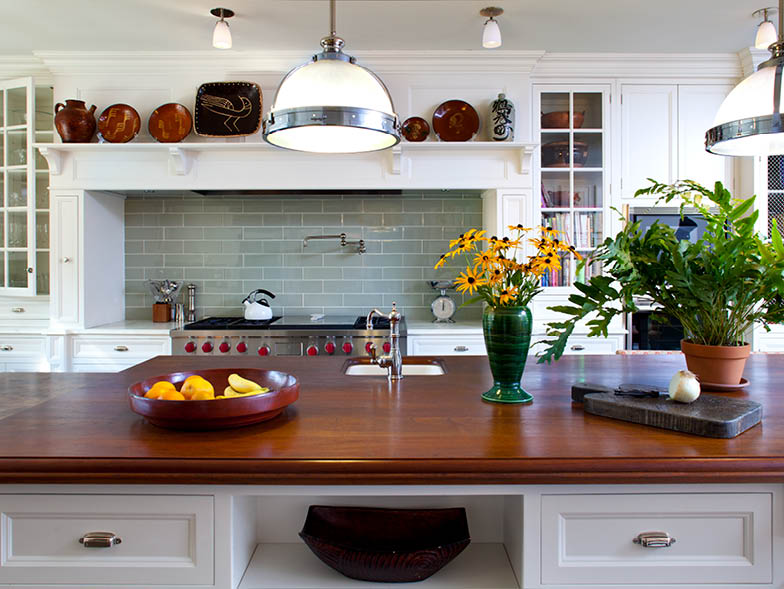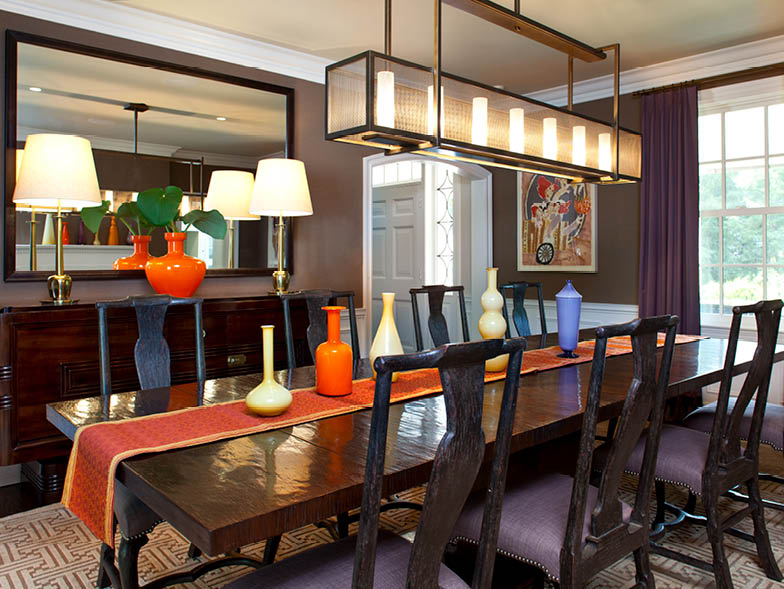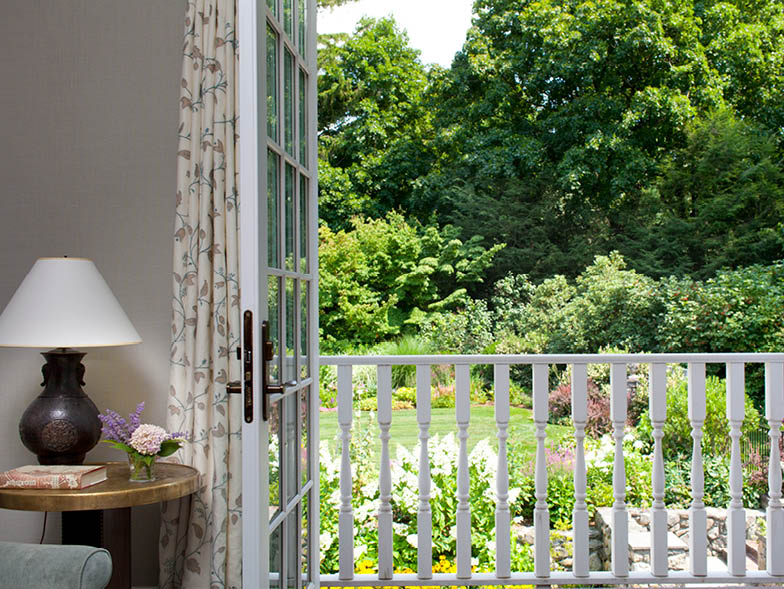Glenn Gissler: Interior Alchemist
Some interior designers focus on art and history, some on architecture, and some on furnishings. Glenn Gissler is a
designer who blends them all into awe-inspiring interior spaces that transcend trends, putting them in a category all their own. Gissler talks about why art plays such a vital role in his work, his approach to bringing a client’s vision to life, and how his latest Westchester, New York, project came to be.
How did you get started in design, and what led you to being so passionate about pursuing this as a career?
When I was just thirteen, I publicly declared to my class that I wanted to be an interior designer. I only knew of one interior designer at the time—a friend of my mother. She was a creative spirit and a painter, and she really inspired me. That was the beginning of a journey that went on to include seven years of college at the Rhode Island School of Design, where I studied architecture and fine arts and honed my expertise in historic preservation and American architecture. In Wisconsin, where I grew up, there wasn’t much in terms of architecture—not like there was in New England. This was the time before the internet, so I was snooping around in books to learn as much as I could. My father worked in journalism, specifically looking at the rebirth of American cities. The idea of adaptive reuse—finding a new purpose for old buildings—was really compelling to him, and this would go on to influence my design approach.

How would you describe your signature style?
I’ve been in the business now for thirty years, and I see design more as a complex layering of textiles and objects—it’s about problem solving. You combine grace and ease with how you live, with one foot in history and one foot in today’s world. If I had to describe my style, I’d go off what others have described it as: American. I also incorporate multicultural aspects to create a dialogue that’s interesting.
What has been your favorite project to work on, and why?
There are projects from twenty-five years ago that are still on my website and are still relevant today. They’re evidence that, when you love your clients and your projects and make thoughtful decisions not based on trends, your work can endure over time. There are oftentimes conceptual challenges involved, because it’s not simply a matter of buying furniture and taking pictures—you’re crafting a lifestyle that makes sense. There was a client I worked with who lived on Park Avenue and the space was conceptually wild, both historically and architecturally. Those are the projects that really engage me.
How do you handle challenges that arise?
I’m lucky to have a team of people who helps me address challenges. Fundamentally, interior design is about isolating what the problems are and coming up with solutions. And the solution needs to be aesthetically pleasing while having functionality. It requires a certain amount of creativity to take, say, a space with a dining room that no one uses, and turn it into something else. It’s not about leaving my mark that says, “Glenn was here!” No, it’s about seeing what’s right for the space and the client. There can be challenges with older houses because the architecture is not meant for today’s living. How do you make a living room livable so it’s not sitting empty until the holidays? I try to have things make sense through a twenty-first-century point of view while keeping the historic element alive.

What is your process like, especially with clients who have a very specific vision for their space?
In the pre-internet days, people had lists of things they had accumulated over time and things they wanted, like a “fantasy country house.” It’s useful to see, but I’m more interested in the house they grew up in and where they see their lives in five years. Kids will be older, so do you want a more private space, or do you want to be the house that everyone wants to hang out in? This is the kind of information I like to gather in our initial conversation. I try to make it about the broader view, too, like if someone lives in a colonial revival but wants a modern look to it. People get overwhelmed by choices, so I try to keep the bigger vision at the center. Even if you hired five different interior designers, my philosophy is that the owner should still be at the core. The project should go through the filter of interior design rather than looking like every home the designer has in his or her portfolio.
What about living and working in New York City inspires you the most?
I’ve been in New York since the mid-‘80s. I lived in Greenwich Village before moving to Brooklyn Heights, where
I reside now. I’ve always been an art collector and an object collector, and I’m constantly moving things in my home from one place to another to keep them dynamic and engaging. My office is near the Flatiron Building, where it’s remained for over twenty years. The architecture and street life around that area have so much vitality. You hear Europeans say, “There’s so much energy in New York!” but, to be honest, I kind of became immune to it after being here for so many years. Social media helps because it keeps that insatiable curiosity alive. My brain sees thousands of images a week between Pinterest and Instagram, so it’s constantly swirling with new ideas. When I’m working on a project and stuck about a chandelier, for example, I go look at my Pinterest boards, which gives me that conceptual turbocharge to see and consider an idea differently.
Describe the Westchester house and what your main inspiration was behind designing it:
It’s a large house in Chappaqua, New York. It was built in the 1920s, with an addition put on at the time that made the house not so useful. They didn’t use the living room or the sunroom, so I suggested architectural corrections that made them much more functional spaces. The sunroom became a real destination within the home. It’s colonial revival, but their taste is contemporary, so it’s about trying to bridge the gap between the two. It was also very flat and earth-toned at first, and I wanted to move on from that and add elements that made for a richer and more dynamic environment. They’re living a version of the American dream—I wanted to show that!

The artwork and the accessories in this home seem to be the focal points. What was your strategy for making this happen?
The single most important thing about interior design is artwork. I view it as artwork with a capital A. Their kitchen has an enormous island with huge walls, and it all seemed kind of cold.
I hung antique botanicals, where you collect samples from nature and press them into a frame with the Latin name written underneath, and they gave the kitchen a fresh look. The stairwell features framed artwork by their three kids, which breathes color and joy into the space. We bought really fantastic pieces for other areas of the house. I’ve been going to museums and art galleries since I was sixteen, and, years later, it filters into the homes I design. For this home, I kept the design meaningful with aspects of history and art but maintained a look that makes sense with their lifestyle.
What was your favorite room to design in the house?
The living room has a grand piano, which makes it really special, and it can accommodate a lot of people in many different ways. But I have to say the sunroom is my favorite. It’s a brightly lit room all year round, with a mix of both historic and modern elements.
There are a lot of bold colors, as well as warmer, neutral tones. How do you find that balance between the two in order to create a space that looks cohesive?
No matter what the budget is, everything you’re spending matters. You don’t want to make decisions
that three years from now will make you wonder, “Why did I do that?” It’s the same with buying things, because someone could say they love color, but tastes are constantly evolving. You want to incorporate items that you can change out without having to start from scratch—like throw pillows, chairs, or artwork. Rugs and sofas cost a fortune! It’s important to make solid decisions that endure the test of time.
What have you learned from the mentors in your life? What advice would you give aspiring interior designers?
My first employer was a designer named Juan Montoya. He was on Architectural Digest’s first Top 100 list and has been since it started. I saw how he ran his business and said, “I can do this.” He gave me that entrepreneurial spirit and relentless curiosity. I look up to people who—whether I know them or not—maintain a curiosity about art, history, and things both old and new. I think it’s vital for aspiring designers to see what’s around every corner—be curious! At the end of the day, you still have to pick out chairs, but always try to inspire people with your work.
For more info, visit gissler.com






















